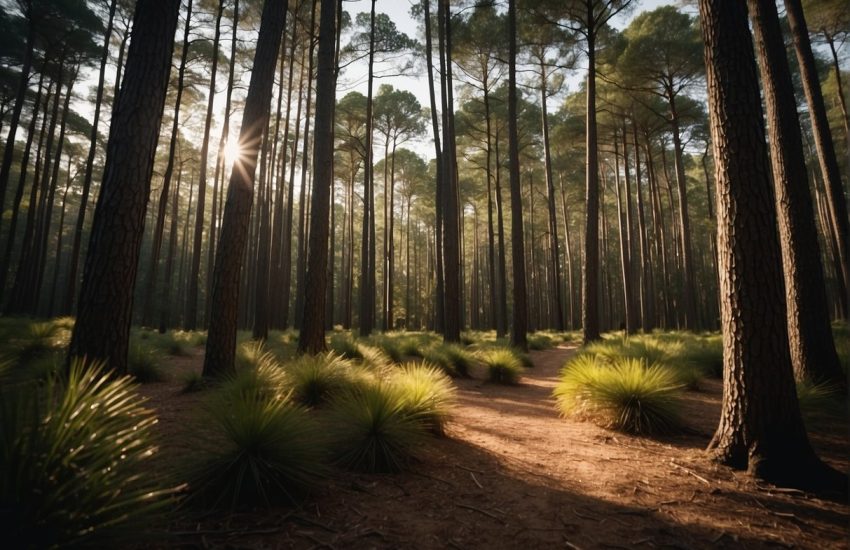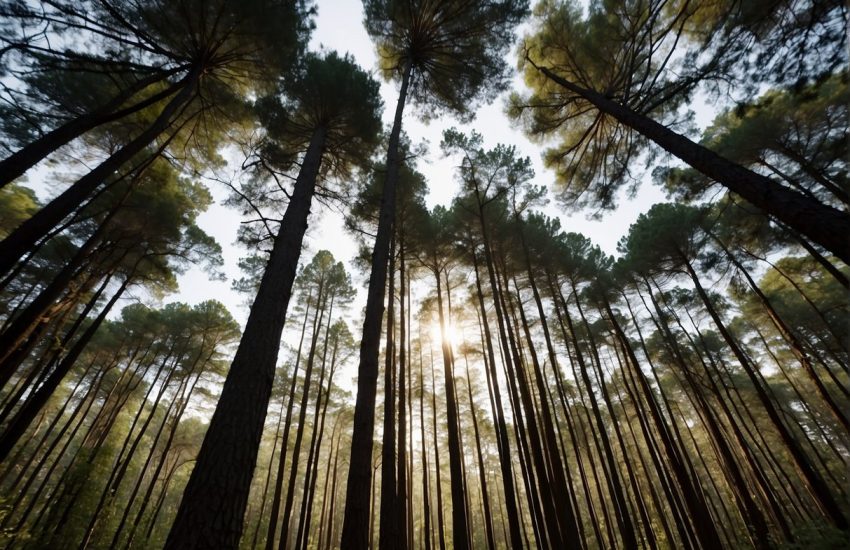Pine Trees in Southern California: Species and Distribution
Pine trees are a common sight in Southern California, and they play a significant role in the region’s ecosystem. These trees are known for their long needles, which can grow up to eight inches in length, and their distinctive cones. There are several different species of pine trees found in Southern California, each with its own unique characteristics and adaptations.

One of the most common species of pine tree found in Southern California is the Coulter pine. These trees can grow up to 80 feet tall and are easily recognized by their large, heavy cones that can weigh up to 10 pounds. Coulter pines are adapted to the dry, hot conditions of Southern California and are often found in chaparral and coastal sage scrub habitats.
Another species of pine tree found in Southern California is the Monterey pine. These trees are native to the central coast of California, but have been widely planted throughout the region as ornamental trees. Monterey pines are known for their distinctive blue-green needles and their ability to grow in a variety of soil types and conditions. Despite their popularity as ornamental trees, Monterey pines are also an important part of the region’s ecosystem and provide habitat and food for a variety of wildlife species.
Pine Trees of Southern California
Native Pine Species
Southern California is home to several native pine species, each with unique characteristics and habitats. The Jeffrey Pine, Bishop Pine, Torrey Pine, Coulter Pine, Knobcone Pine, and Monterey Pine are the most common species found in the region.
The Jeffrey Pine is known for its tall stature and reddish-brown bark. It is commonly found in the San Bernardino and San Jacinto Mountains. The Bishop Pine, on the other hand, is found in the coastal regions of central and southern California and is known for its twisted branches and blue-green needles. The Torrey Pine is a rare species found only in the Torrey Pines State Natural Reserve in San Diego County. It has a distinctive gnarled appearance and long needles. The Coulter Pine, also known as the Big-cone Pine, is found in the southern coastal ranges and has large cones that can weigh up to 10 pounds. The Knobcone Pine is found in the foothills of the San Gabriel and San Bernardino Mountains and has small, twisted cones. The Monterey Pine is found along the central coast and has long, soft needles and a distinctive bark.
Pine Tree Habitats
Pine trees in Southern California can be found in a variety of habitats, from coastal regions to mountainous areas. The Jeffrey Pine, Bishop Pine, and Coulter Pine are commonly found in the mountains, while the Torrey Pine is found only in the coastal region. The Knobcone Pine is found in dry, rocky soils in the foothills, while the Monterey Pine is found in coastal areas with sandy soils.
Pine trees play an important role in the ecology of Southern California, providing habitat for a variety of wildlife and helping to stabilize soil and prevent erosion. They also have cultural significance for many indigenous communities in the region.
Physical Characteristics and Adaptations

Needles and Cones
Pine trees are evergreen conifers that are commonly found in Southern California. They have long, stiff needles that can range in color from gray-green to bluish-green. The needles grow in bundles of two or three and can be up to 8 inches long. Pine trees also produce egg-shaped cones that can range in color from green to brown.
The cones of pine trees are adapted to release their seeds in response to fire. The heat from a fire causes the cones to open and release their seeds, which can then germinate in the newly cleared area. This adaptation allows pine trees to thrive in areas with a high risk of wildfires.
Growth and Soil Requirements
Pine trees typically grow best in full sun and require well-drained soils. They can tolerate poor soils, including sandy soils, but may not grow as tall or as fast in these conditions. Pine trees have reddish-brown bark that is thick and scaly, which helps protect them from fire and other environmental stressors.
Pine trees are known for their ability to grow in a variety of conditions, including areas with low water availability and poor soils. Their physical characteristics and adaptations allow them to thrive in Southern California‘s diverse landscapes.
Ecological Significance and Uses

Ecosystem Services
Pine trees in Southern California play a crucial role in maintaining the region’s ecosystem. They provide habitat for wildlife, including birds, squirrels, and insects. Pine needles and cones provide organic matter that enriches the soil and supports the growth of other plants. The trees also help to prevent soil erosion and regulate water flow by absorbing excess water during heavy rains and releasing it during dry periods.
Pine trees are also important for air quality in the region. They absorb carbon dioxide and release oxygen, helping to reduce greenhouse gases and improve air quality.
Human Utilization
Pine trees have been used by humans for a variety of purposes for centuries. They are a source of timber, used for construction, furniture, and paper products. The wood from pine trees is also used for ornamental purposes, such as carving and decorative paneling.
In addition to their timber uses, pine trees have edible parts. The seeds of some species, such as the piñon pine, are a traditional food source for Native American communities in the region. The needles of some species can also be used to make tea, which is rich in vitamin C.
Pine trees are also popular for their aesthetic value, with their distinctive foliage and cones used in holiday decorations and landscaping. Many species of pine trees are drought-tolerant and can thrive in the arid climate of Southern California, making them an important part of the region’s landscaping and green spaces.
Overall, pine trees in Southern California have significant ecological and human uses, making them an important part of the region’s natural and cultural heritage.
Conservation and Challenges

Impact of Drought
Pine trees are an important part of Southern California’s ecosystem, but they are facing numerous challenges due to the region’s ongoing drought. Drought conditions can weaken the trees, making them more susceptible to pests and disease. In addition, drought-stressed trees are more likely to catch fire, which can be especially dangerous in areas with a high risk of wildfires.
Conservation Efforts
To help protect Southern California’s pine trees, conservationists are taking action to promote drought tolerance and resilience. One approach is to plant drought-tolerant species of trees that can better withstand dry conditions. Another strategy is to reduce water usage in urban areas, which can help conserve water resources for natural habitats.
In addition, conservationists are working to address the underlying causes of drought, such as climate change. By promoting policies and practices that reduce greenhouse gas emissions, it may be possible to slow the rate of climate change and mitigate its impacts on Southern California’s ecosystems.
Overall, the conservation and protection of Southern California’s pine trees is an ongoing challenge, but with continued efforts and innovative solutions, it is possible to safeguard these important species for future generations.


